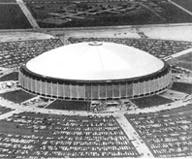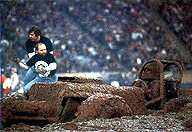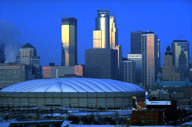 The development of the enclosed superstadium is a
major phenomenon in the recent history of American culture and technology.
Since the Houston Astrodome's opening in 1965 marked the birth
of the superstadium (figure 1), these unprecedented buildings
have multiplied the profits of major league sports teams by bringing
games indoors - making baseball rain delays obsolete and December
football games comfortable. Superstadiums serve as giant television
studios for broadcasting the events they house, and their luxury
skyboxes bring surrogate living rooms and even corporate boardrooms
into the modern arena. Revenues from these luxury boxes and from
season-long television broadcast contracts have enriched the superstadiums'
major league tenants, but these structures rarely make money for
the cities that build and maintain them.
This is true in spite
of the fact that controlled climates and huge projection screens
allow these domes to host a wide variety of spectacles, from monster-truck
races to political conventions to superbowls (figure 2).
The development of the enclosed superstadium is a
major phenomenon in the recent history of American culture and technology.
Since the Houston Astrodome's opening in 1965 marked the birth
of the superstadium (figure 1), these unprecedented buildings
have multiplied the profits of major league sports teams by bringing
games indoors - making baseball rain delays obsolete and December
football games comfortable. Superstadiums serve as giant television
studios for broadcasting the events they house, and their luxury
skyboxes bring surrogate living rooms and even corporate boardrooms
into the modern arena. Revenues from these luxury boxes and from
season-long television broadcast contracts have enriched the superstadiums'
major league tenants, but these structures rarely make money for
the cities that build and maintain them.
This is true in spite
of the fact that controlled climates and huge projection screens
allow these domes to host a wide variety of spectacles, from monster-truck
races to political conventions to superbowls (figure 2).
 Superstadiums have not only changed sports spectating in America
but have also transformed the cities in which they stand. Constructing
a superstadium is a major civic investment that makes a profound
impact on a city's fabric, altering circulation systems, parking
demands and neighborhood scales. Such effects make superstadiums
lighting rods for hotly contested political debates in cities
that contemplate building one, as are many American cities today.
The Houston Astrodome, the Minneapolis Metrodome and the Superdome
in Atlanta provide three early case studies of how cities have
dealt with these unwieldy forms.
Superstadiums have not only changed sports spectating in America
but have also transformed the cities in which they stand. Constructing
a superstadium is a major civic investment that makes a profound
impact on a city's fabric, altering circulation systems, parking
demands and neighborhood scales. Such effects make superstadiums
lighting rods for hotly contested political debates in cities
that contemplate building one, as are many American cities today.
The Houston Astrodome, the Minneapolis Metrodome and the Superdome
in Atlanta provide three early case studies of how cities have
dealt with these unwieldy forms.
America's Superstadiums are predominately covered by cable-stiffened pneumatic roofs or tensegrity domes, both invented since World War II. These new structural types were first erected to enclose World Exposition and Olympic buildings. Exposition and Olympic sponsors' need for economic longspan roofs and their openness to experimentation helped inspire the design of the first large pneumatic dome at the U.S. Pavilion at Expo 70 in Osaka, and the first tensegrity dome over the Fencing and Gymnastics Arenas at the 1988 Seoul Olympics. The relative economy of both roof forms helped ensure their quick adaptation for use in America's Superstadiums (figure 3, Minneapolis Metrodome, figure 4 Atlanta Georgia Dome). The U.S. Pavilion, for example, weighed less than one fifth that of traditionally constructed domes of similar size such as the Houston Astrodome, and cost much less per square foot.

 The history of the inception of these new structural types illustrates
an extraordinary confluence of engineering brilliance and technology
transfer. The theoretical groundwork for tensegrity domes was
laid by R. Buckminster Fuller -- the creator of the geodesic dome
-- but the first successfully built, large-scale tensegrity structure
was designed by David Geiger, the inventor of the cable-stiffened
pneumatic dome and the structural engineer of the U.S. Pavilion.
Pneumatic and tensegrity domes owe their existence in part to
recent technological developments in unrelated disciplines, and
are prime examples of technological adaptation. Both types of
domes rely on advances in computer hardware and the science of
numerical methods that make predicting their structural performance
possible; both also employ fiberglass fabric developed for NASA
and coatings first used by the space program.
The history of the inception of these new structural types illustrates
an extraordinary confluence of engineering brilliance and technology
transfer. The theoretical groundwork for tensegrity domes was
laid by R. Buckminster Fuller -- the creator of the geodesic dome
-- but the first successfully built, large-scale tensegrity structure
was designed by David Geiger, the inventor of the cable-stiffened
pneumatic dome and the structural engineer of the U.S. Pavilion.
Pneumatic and tensegrity domes owe their existence in part to
recent technological developments in unrelated disciplines, and
are prime examples of technological adaptation. Both types of
domes rely on advances in computer hardware and the science of
numerical methods that make predicting their structural performance
possible; both also employ fiberglass fabric developed for NASA
and coatings first used by the space program.Housing the Spectacle traces the advent and evolution of America's extraordinary Superstadiums. The exhibition explores the confluence of cultural desires, economic dictates, and technological advances that propelled the evolution of domed superstadiums from heavy ribbed steel domes, through pneumatic cable-stiffened structures, to tensegrity roofs. Case studies of five domes -- the 1965 Houston Astrodome, the 1970 U.S. Pavilion at Expo 70 in Osaka, the 1981 Minneapolis Metrodome, the 1988 Seoul Olympic Fencing and Gymnastics Arenas and the 1992 Georgia Dome -- illustrate this evolution and the forces that shaped it.
 Housing the Spectacle Main Menu
Housing the Spectacle Main Menu